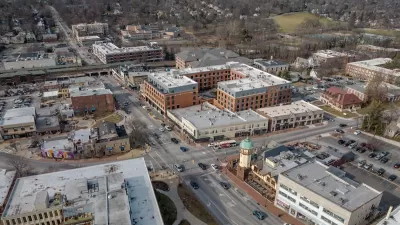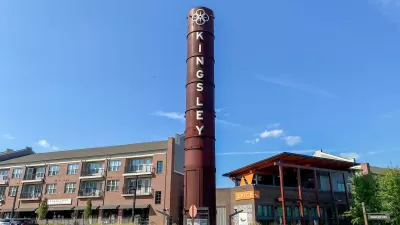This article from City Journal looks at the anti-modernist architect Leon Krier's plan for remaking suburbs into self-contained towns.
"What makes Krier new, and so important for us at the critical point that we have now reached-when everyone apart from professional architects recognizes that cities, to flourish, require a centripetal force to replace the centrifugal-is that he has a clear and persuasive remedy, one that town planners and builders everywhere could easily adopt and that citizens would embrace immediately if it were put to the vote."
"Krier's solution is to replace the "downtown plus suburbs" system with that of the polycentric settlement. If people move out, then let it be to new urban centers, with their own public spaces, public buildings, and places of work and leisure: let the new settlements grow, as Poundbury has grown next to Dorchester, not as suburbs but as towns. For then they will recapture the true goal of settlement, which is the human community in a place that is 'ours' rather than individual plots scattered over a place that is no one's. The towns will create a collection of somewheres instead of an ever-expanding nowhere. This solution has a precedent: the city of London grew next to the city of Westminster in friendly competition, and the residential areas of Chelsea, Kensington, Bloomsbury, and Whitechapel arose as autonomous villages rather than as spillovers from the existing centers."
"The only thing needed to achieve this effect, Krier argues, is a master plan. By this, he means not one of those sinister experiments in social engineering that appealed to the modernists but a simple set of rules within which people can make the choices best suited to their needs. Krier's master plan involves an overall layout, a street plan for each quarter, and rules governing such things as the shape of plots, the number of floors permitted in buildings (five, in Krier's view, is the natural maximum), and the materials and technical configurations to which structures should conform. His aim is to control the quality of 'normal, regular and inevitable building.'"
FULL STORY: Cities for Living

Manufactured Crisis: Losing the Nation’s Largest Source of Unsubsidized Affordable Housing
Manufactured housing communities have long been an affordable housing option for millions of people living in the U.S., but that affordability is disappearing rapidly. How did we get here?

Americans May Be Stuck — But Why?
Americans are moving a lot less than they once did, and that is a problem. While Yoni Applebaum, in his highly-publicized article Stuck, gets the reasons badly wrong, it's still important to ask: why are we moving so much less than before?

Research Shows More Roads = More Driving
A national study shows, once again, that increasing road supply induces additional vehicle travel, particularly over the long run.

Judge Halts Enforcement of Anti-Homeless Laws in Grants Pass
The Oregon city will be barred from enforcing two ordinances that prosecute unhoused residents until it increases capacity and accessibility at designated camping sites.

Advancing Sustainability in Los Angeles County Schools
The Los Angeles County Office of Education’s Green Schools Symposium brings together educators, students, and experts to advance sustainability in schools through innovative design, climate resilience strategies, and collaborative learning.

Using Old Oil and Gas Wells for Green Energy Storage
Penn State researchers have found that repurposing abandoned oil and gas wells for geothermal-assisted compressed-air energy storage can boost efficiency, reduce environmental risks, and support clean energy and job transitions.
Urban Design for Planners 1: Software Tools
This six-course series explores essential urban design concepts using open source software and equips planners with the tools they need to participate fully in the urban design process.
Planning for Universal Design
Learn the tools for implementing Universal Design in planning regulations.
City of Moreno Valley
Institute for Housing and Urban Development Studies (IHS)
City of Grandview
Harvard GSD Executive Education
NYU Wagner Graduate School of Public Service
City of Cambridge, Maryland
Newport County Development Council: Connect Greater Newport





























